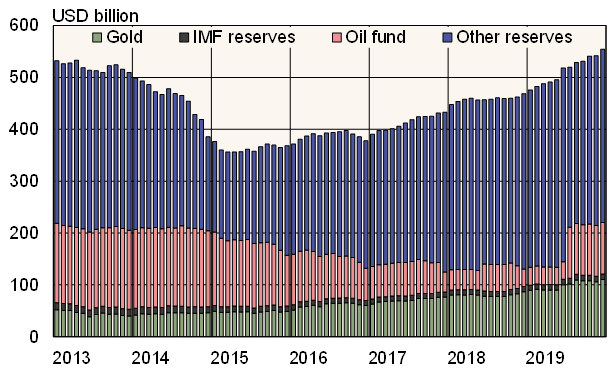BOFIT Weekly Review 03/2020
Oil revenues also boost Russia’s foreign currency and gold reserves
The CBR reports that the value of its foreign currency and gold reserves at the end of last year climbed to 554 billion dollars, an 86-billion-dollar increase from the end of 2018. The increase in the reserves was mainly due to higher oil & gas revenues. The amount oil & gas revenues is reflected in the reserves due to CBR currency market operations conducted in accordance with the government’s fiscal rule. The rule states that when the oil price exceeds the basic oil price (42 dollars a barrel in 2020), the CBR must purchase foreign currency from the market (or correspondingly sell forex when the oil price falls below the basic price). The purpose of these forex interventions is to reduce fluctuations in the ruble’s exchange rate caused by shifting oil prices. The Ministry of Finance announces the amount of these market operations in advance every month.
The liquid assets of Russia’s oil fund, the National Welfare Fund (99 billion dollars at the end of last year), are treated as a component of Russia’s foreign currency reserves, even if their primary purpose is different from that of currency reserves generally. NWF assets are mainly intended to be used to smooth cyclical fluctuations in budget expenditures. Foreign currency and gold reserves, in contrast, serve largely as a buffer against unexpected shocks to foreign financing. When NWF assets are used, for example, to cover a budget deficit (i.e. ruble-denominated spending), it does not directly affect the value of the currency reserves as the central bank provides rubles for the finance ministry in exchange for the forex assets. The NWF’s share of Russia’s foreign currency reserves shrinks, however.
Russia’s currency and gold reserves are relatively large by international standards. The currency reserves (excluding gold) are sufficient to cover more than a year’s worth of imports of goods and services, or more than three times that needed to cover Russia’s short-term foreign debt.
The structure of Russia’s foreign currency reserves has remained fairly constant since spring 2018, when the CBR moved some of its dollar investments into yuan-denominated assets. At the end of June 2019, 30 % of Russia’s reserves were in euros, 24 % in dollars and 13 % in yuan. Gold made up about 20 % of the reserves.
Russia’s foreign currency and gold reserves

Sources: CBR and Russian Ministry of Finance.